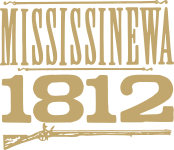Pleasant View Elementary School
- Barb Adams

- Feb 19
- 4 min read
Updated: Mar 20

On Wednesday, February 19, 2025, a group of living historians “invaded” Pleasant View Elementary School in Yorktown, Indiana. They presented to 9 classes of second grade students, a total of about 180 students. Dressed in 1812 clothing, each living historian shared their experiences with the teachers and students. Here is a brief synopsis of each presentation…

Barb Adams had the students help display the different articles of clothing men and women wore and why each piece of clothing was important. Men wore stockings with garters, nickers with buttons (no zippers), a frock, wool vest, and neckerchief which helped to protect them from the sun. A cap and hat were worn to protect the head, and leather shoes and laces were worn by both men and women. Women wore a chemise, petticoats, chemisette, and gown. India-print cotton was used for the gown on display. She explained ladies also wore stockings and usually were kept up with ribbon garters. Ladies always wore a cap all during the day and a bonnet when going outside. No sewing machines in 1812, so all clothing was hand stitched. There was no elastic, so strings were used around the neckline and high waistline to make the dress fit. Wool, linen, and cotton were used to make clothing.

Kiley Stiers explained that back in 1812, material was expensive, and all leftover scraps were saved and used for other things. She showed how to make toys from material scraps. Kiley explained that material has a weft and warp weaving. Ripping fabric on the warp made it easier to form strips for projects. The bias of the fabric was stretchy and could not be used as easily. Kiley displayed different types of dolls and some other toys, like balls, that could be made with fabric scraps. She explained that children’s toys all had to be made by hand with materials readily available in 1812.

Mark Kreps showed students a canteen used to hold water and explained why water was important when traveling or hunting animals. He explained that rivers run south, and animals were usually spotted along the river. Fish in the river provided food for some animals and helped in feeding the family. Mark explained the roles of women, men, and children back in 1812. He had furs for the students to identify and displayed some animal traps, deerskin and antlers. Mark talked about various animals found in the Indiana Territory such as skunks and otters (which can stay under water for 8 minutes). Indians taught us how to trap the otters and other night-time animals. He explained how animals, such as the wolf, were dangerous and would attack farm animals, stagecoaches, and people. When traveling at night, groups of people would sing to alert the animals to run away.

Janet Kreps talked about different types of kitchen equipment and cooking methods used in 1812, such as open-hearth cooking, a tin kitchen with a rotisserie, and a reflector oven used for pies and cornbread. She told the students that when taking a trip families would bring apple seeds to plant when they arrived at their new homestead. Women dried apples, peas, and corn that could be rehydrated and used for pies or soups. They could use corn and barley grain to grind to make flour for making bread. Vinegar and salt were used as a preservative for vegetables and meat.

Thad Stern explained to the children a little about how the war of 1812 started and how it affected those living in the Indiana Territory, Kentucky and Ohio. He talked about how soldiers, during war time, had to make their own bullets. He displayed a tomahawk and other equipment a soldier would need. Thad explained the reason we have to fight in wars. "We need soldiers to protect the things we love…our country, our families, and our freedoms." Thad told the students about when Indiana became a state. He explained that soldiers had to make their own clothes such as shirts and frocks. They also had to learn how to be their own blacksmith to make things they needed when they were away fighting battles.
Charlie Rutherford presented with Thad and showed the students things like gun powder, a deer hide, and an arrow. He explained how the soldiers could travel 170 miles in about 2 weeks. He also explained why the War of 1812 was started.

Dennis Adams portrayed a wood craftsman. He told the students that pioneers seeking out new homesteads didn’t bring furniture with them, they brought wood to make the furniture when they settled into their new home. Also, only the metal heads for axes, shovels, hammers, and other tools were brought and the handles would be carved out of wood when they reached their destination. Dennis told the students how toys were made of wood, how to notch wood, and how wooden boxes were made for keeping valuables that they could grab in a hurry and keep their valuables safe.

John Davis discussed what is important to have when scouting and what needed to be brought and what was not important to take on a long trip. He talked about what they would eat during a scouting session, how to heat food, and how to be safe during the trip. The scouts must be observant and would have to always look for invaders, finding places where people could settle, mapping, and recording all the things and animals they encountered along the way. Scouts were necessary people who were familiar with the land.
Kindly Written By Barb Adams



